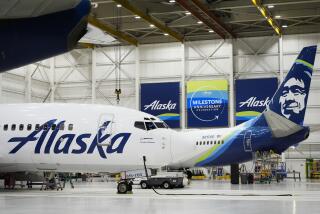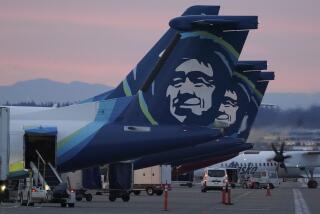Aloha’s Lesson--Buckle Down and Buckle Up
- Share via
“Please observe the ‘Fasten Seat Belt’ sign . . . “
Most of the 95 passengers and crew aboard Thursday’s Aloha Airlines Flight 243 from Hilo to Honolulu were doing just that. But as the jetliner approached its cruising altitude of 24,000 feet, three stewardesses released their harnesses to walk the aisle and take drink orders.
Minutes later, an explosive decompression blew out the front section of the Boeing 737.
“Those people who weren’t buckled up, the stewardesses . . . we lost one of those and the other two, well, the people in the aisle seat had to hold on to them or they would have gone also,” remembers passenger Dan Dennin. “The people who were sitting up in the front of the plane, if they had not had their belts on, I’m sure they would have all gone out of the plane.”
Seat Belts Are Lifesavers
The message in that, said aviation and air safety experts Monday, is that, at any stage of a flight, seat belts are lifesavers.
“The seat-belt light was on (aboard Flight 243), seat belts were in place, and it does appear that they contributed to a significant saving of human lives,” said a National Transportation Safety Board spokesman. He was interviewed by telephone on Maui where federal investigators continue to explore the cause of the midair blast. “It does appear that seat belts are invaluable.”
The relative good fortune of Flight 243, said passenger Dennin, 31, a salesman, was in the shortness of the journey.
“Normally on these inter-island flights you just sit down and buckle in and stay that way because most (flights) are only 30 minutes,” he explained in a telephone interview from his Honolulu home. “But I’ve worn a seat belt from the moment I learned to drive . . . even if I’m flying across country for five hours, if I’m in my seat I’ll always have the belt on.”
A Reminder to Be Ignored
But not all passengers, said aviation industry representatives, are like Dennin. Most will follow federal air safety mandates and buckle their belts for takeoff and landing. But too many, they say, believe that when the seat-belt light is out, the captain’s standard suggestion to keep seat belts loosely fastened is a reminder to be ignored.
And in the past 24 months, the toll to turbulence and sudden maneuvers has been this:
--A dozen people treated at hospitals after a Sabena DC-10 dipped sharply in thunderstorms near Detroit.
--Eighteen people injured, two seriously as they were tossed about the cabin of an Eastern Airlines flight near Miami.
--A Mexican Airlines flight en route from Mexico City to Philadelphia, forced to land at San Antonio, Tex., with 22 passengers injured by turbulence.
--Forty-one people hurt when an Eastern Airlines flight from San Juan, Puerto Rico, to New York was rocked by turbulence at 33,000 feet.
The comparative rarity of such incidents, said one safety specialists, has lulled many air travelers into thinking that accidents only happen to the other passenger.
“But airplane seat belts are just like car seat belts,” he explained. “You may wear that belt 100,000 times over your lifetime and never need it but once . . . but the one time is when the other 99,999 pay off.”
Daphne Dicino, a spokeswoman for Phoenix-based America West is an habitual seat belt user:
“Once, on a trip to Florida in a terrible storm, I saw someone just bounce right up and smash into the overhead. I thought to myself: ‘Gee, I don’t ever want to do that.’ I’ve worn a seat belt ever since.”
In Use Since the ‘30s
Seat-belt signs and their illumination for takeoff and landing have been fixtures on airliners since the Douglas DC-3s of the ‘30s.
“But the suggestion that you hear during a flight that you keep your seat belt on even though the sign is off, was largely at the instigation of the Airline Pilots Assn. back in the mid-’70s,” said an association representative in Washington.
His organization, he said, saw no “particular need” to repeat its position on wearing seat belts throughout a flight. Nor does he think it should become a Federal Aviation Administration ruling.
“Let me point out that approximately 85% of all airline accidents occur within a couple of miles of the airport when you are required to wear a seat belt anyway,” he added. “So when you look at what happened aboard the Aloha flight, you see that the (existing) concept works . . . in this case, there was an accident that did explicitly test that (seat-belt) question and the answer appears to be: ‘Yes, people are wearing them.’
“If we’d had an Aloha incident where a number of passengers sitting in their seats had also been blown out, I think you would have seen some sort of hue and cry for a mandatory (seat-belt wearing) rule.”
Among the nation’s private air accident investigators, however, there are many who believe that today’s requirements are only a bare minimum.
‘A Little Bit More’
“When I see a flight crew and stewardesses wearing seat belts and shoulder harnesses for takeoffs and landings, I sometimes wish the airline had provided me with just a little bit more,” said aeronautical engineer Tom Lombardo, president of Lomtek Inc., an accident reconstruction, prevention and investigation firm in Atlanta.
Former National Aeronautics and Space Administration consultant Richard Snyder of Tucson, a veteran biomechanic specializing in human impact protection, said that airline seats just aren’t tough enough.
They are designed, he explained, to withstand “minimal” gravity forces of 9Gs forward and 3Gs vertical. Better, he suggested, that airlines consider a seat once designed for NASA that is stressed to withstand 23Gs forward and 43Gs vertical.
Snyder also would like to see airline passengers protected as flight attendants are protected--by seat and shoulder belts and rearward facing seats.
“I never take my belt off on a flight,” he said.
Snyder--who said he survived five airplane crashes as an Air Force pilot--said the number and severity of today’s air accidents suggests greater industry attention to the NASA seat, to the installation of air bags in seat belts, shoulder straps, to special restraint systems for children.
He would also like to see industry availability of “smoke hoods” developed by the FAA in 1968.
Snyder has carried one for 18 years. It has been with him on the 52 airline flights he has made since January. “It will take 1700 degrees and give me five minutes of rebreathing time against toxic fumes.”
More to Read
Sign up for The Wild
We’ll help you find the best places to hike, bike and run, as well as the perfect silent spots for meditation and yoga.
You may occasionally receive promotional content from the Los Angeles Times.






